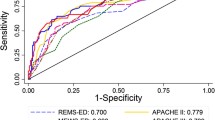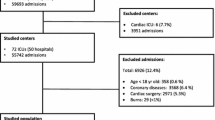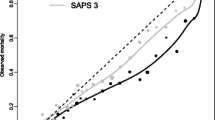Abstract
Objective
To assess how the power of discrimination of a multipurpose severity score (Simplified Acute Physiology Score; SAPS) changes in relation to the length of stay (LOS) in the intensive care unit (ICU).
Design
In order to compute the SAPS probability, a model derived from logistic regression was developed in a cohort of 8059 patients. Measures of calibration (goodness-of-fit statistics) and discrimination [receiver operating characteristic (ROC) curve and relative area under the curve (AUC)] were adopted in a developmental set (5389 patients) and a validation set (2670 patients), both randomly selected. Once the logit was developed and the model validated, the whole database (8059 patients) was again assembled. To evaluate the accuracy of first-day SAPS probability over time, area under the ROC curve was computed for each of the initial 10 days of ICU care and for day 15.
Setting
24 Italian ICUs.
Patients
A total of 8059 patients out of 10065 consecutive admissions over a period of 3 years (1990–1992) were included in this study. Patients whose SAPS was not correctly compiled (n=687), patients younger than 18 years (n=442), and patients whose LOS was less than 24 h (n=877) were excluded from this analysis.
Interventions
None.
Measurements and results
The logistic model gave good results in terms of calibration and discrimination, both in the developmental set (goodness-of-fit:X 2=9.24,p=0.32; AUC=0.79±0.01) and in the validation set (goodness-of-fit:X 2=8.95,p=0.537; AUC=0.78±0.01). The AUC for the whole database showed a loss in discrimination closely related to LOS: 0.79±0.01 at a day 1 and 0.59±0.02 at day 15.
Conclusion
The logistic model that we developed meets high standards for discrimination and calibration. However, SAPS loses its discriminative power over time; accuracy of prediction is maintained at an acceptable level only in patients who stay in the ICU no longer than 5 days. The stay in the ICU represents a complex variable, which is not predictable, that influences the performance of SAPS on the first day.
Similar content being viewed by others
References
Fagon JY, Slama MA, Novara A (1994) Outcome prediction systems based on organ failures. Rèan Urg 3: 195–199
Jacobs S (1994) Outcome scoring in critically ill patients. Rèan Urg 3: 177–181
Wagner DP, Knaus WA, Harrell FE, Zimmerman JE, Watts C (1994) Daily prognostic estimates for critically ill adults in intensive care units: results from a prospective, multicenter, inception cohort analysis. Crit Care Med 22: 1359–1372
Carugo D, Dei Poli M, Guarino A, Navalesi P, Radrizzani D, Ravizza A, Roveda F, Sicignano A, Vesconi S (1994) ARCHIDIA: a computer based system of patient data collection. Part I — Methodology. Minerva Anestesiol 60: 253–260
Le Gall JR, Loirat P, Alperovitch A, Glaser P, Granthil C, Mathieu D, Mercier P, Thomas R, Villers D (1984) A simplified acute physiology score for ICU patients. Crit Care Med. 12: 975–977
Guerrero VM, Johnson RA (1982) Use of Box-Cow transformation with binary response models. Biometrika 69: 309–314
Le Gall JR, Lemeshow S, Saulnier F (1993) A new simplified acute physiology score (SAPS II) based on a European/North American multicenter study. JAMA 270: 2957–2963
Lemeshow S, Le Gall JR (1994) Modelling the severity of illness of ICU patients — a system update. JAMA 272: 1049–1055
Hanley JA, McNeil BJ (1982) The meaning and use of the area under a receiver operating characteristic (ROC) curve. Radiology 143: 29–36
Hanley JA, Mcneil BJ (1983) A method of comparing the areas under receiver operating characteristic curves derived from the same cases. Radiology 148: 839–843
Lemeshow S, Klar J, Teres D, Avrunin JS, Gehlbach SH, Rapoport J, Ruè M (1994) Mortality probability models for patients in the intensive care unit for 48 or 72 hours: a prospective multicenter study. Crit Care Med 22: 1351–1358
Gilbert J, Schoolfield J, Gaydou D, McFee A, Smith B (1990) Modified system outcome score and outcome index. Method of monitoring patient care in a special care area. Crit Care Med 18: 596–602
Brennan TA, Locatio AR, Leape LL (1990) Identification of adverse events occurring during hospitalization. Ann Intern Med 112: 221–226
Author information
Authors and Affiliations
Consortia
Additional information
ARCHIDIA (Archivio Diagnostico): A complete list of study participants appears in theAppendix
Rights and permissions
About this article
Cite this article
Sicignano, A., Carozzi, C., Giudici, D. et al. The influence of length of stay in the ICU on power of discrimination of a multipurpose severity score (SAPS). Intensive Care Med 22, 1048–1051 (1996). https://doi.org/10.1007/BF01699226
Received:
Accepted:
Issue Date:
DOI: https://doi.org/10.1007/BF01699226




